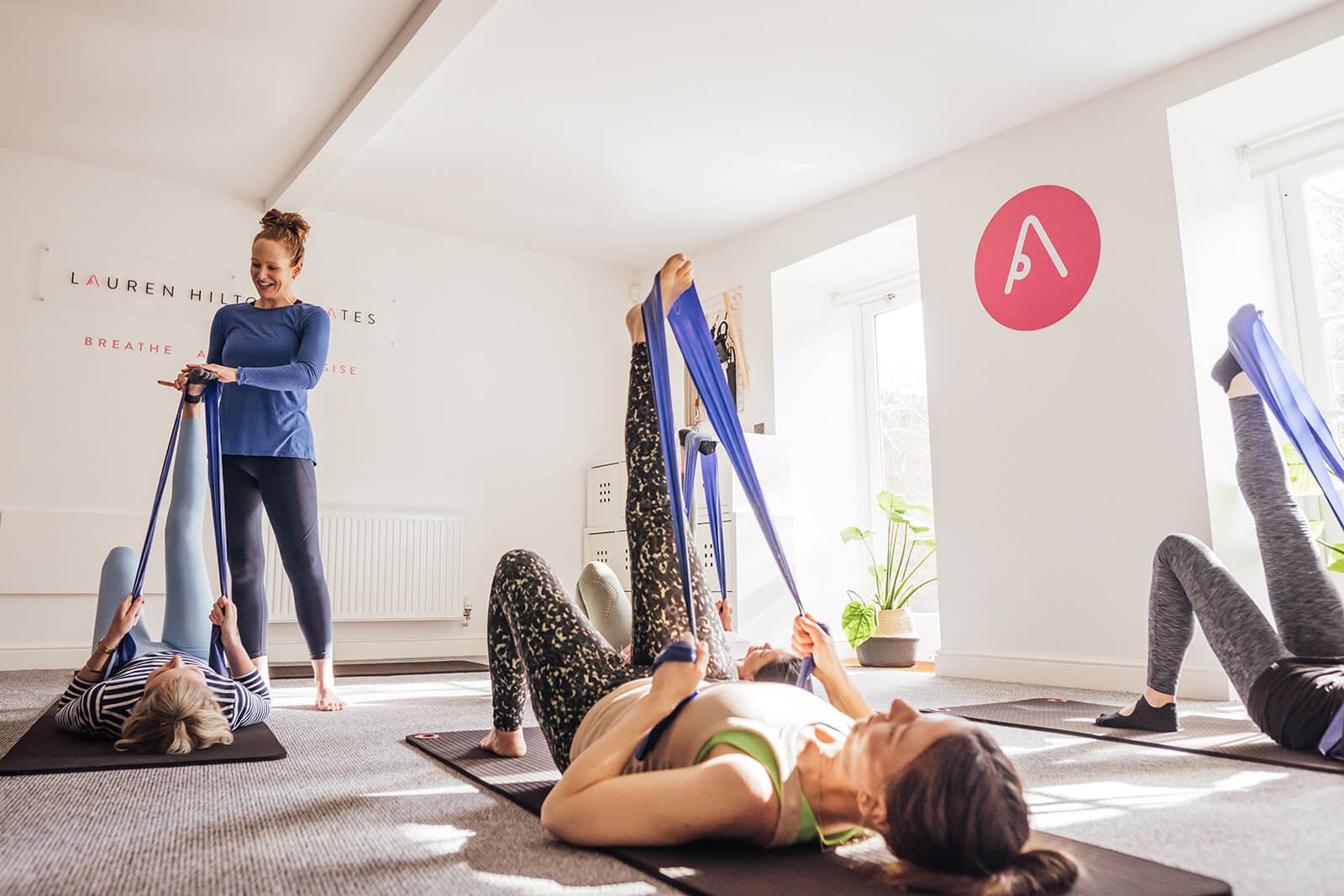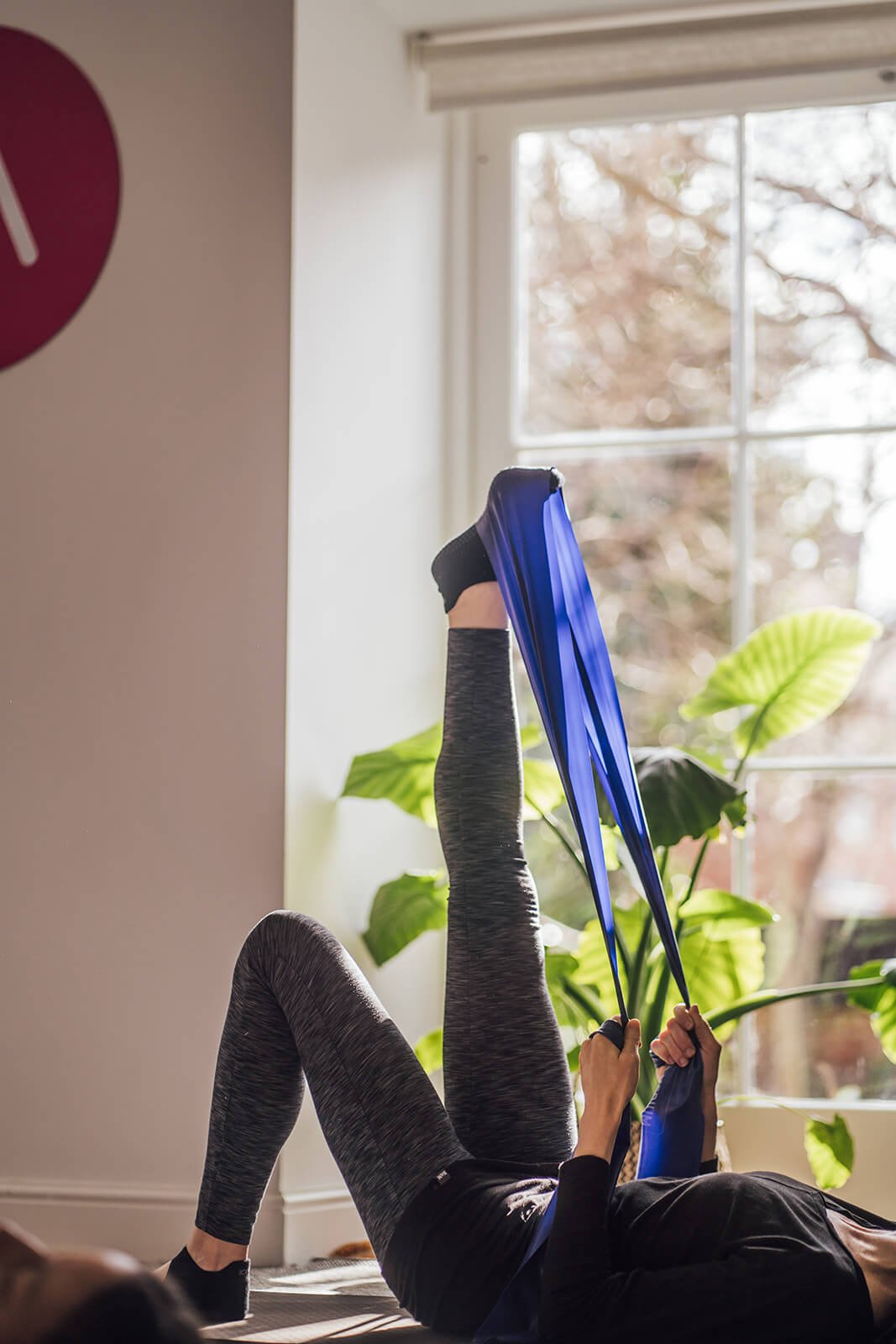5 benefits of using resistance props in your Pilates mat work
At Lauren Hilton Pilates we use the resistance of the springs and pulleys in our one-to-one sessions using the reformer and tower bar, as well as in our group equipment classes, but we also love to use them in our mat classes too!
The great thing about these Pilates props is that they are very affordable so they can enhance your home practice too!
Adding props to exercises in Pilates can both help support you or challenge you. For example, you may be struggling to do the Pilates roll-up but simply by adding a resistance band wrapped around your legs or holding a magic circle between the ankles this often elusive movement becomes achievable, this is because it gives our body valuable feedback of what muscles need to connect in order to move. Let’s dig into the resistance props used in Pilates practice.
The Magic Circle, aka a fitness circle, exercise ring, or Pilates ring.
This was one of the props designed by Joseph and it is rumoured to have been created from the top of a beer keg! instead of an old beer keg, these days the Pilates magic circle is made of rubber with small pads on either side to cushion hands or ankles as they push against it. Most circles are also padded in a way that supports hands or feet when they are inside the ring pressing outwards. The magic circle is made from (relatively) flexible material and is designed to provide a variable amount of resistance depending on how hard it is being squeezed.
The magic circle provides gentle to moderate resistance in an exercise. When you see the magic circle it can be tempting to squeeze it with all your might, but instead, this prop is designed to be mindfully integrated into the body to support or challenge you during exercises. This means it is usually used under gentle tension to activate muscles. By gently pressing into the circle with our arms we stimulate our pelvic floor and deeper abdominals which may assist us in certain movements, equally we also want to challenge certain movements too so by placing the circle between the inner thighs we add resistance to any leg exercises.
This is why we love the props so much, they can help us connect more deeply to our practice so we have those ah-ha moments when we can’t ‘feel’ a certain movement and they can also help us when we’re just starting out in Pilates.
Resistance band, fitness band, TheraBand
This prop is known by lots of different names, whatever your name for it, the stretchy band has many great properties making it the perfect addition to any Pilates practice.
If you’re a Pilates lover looking for a challenge the resistance band can make both mat and equipment exercises more difficult. Plus, including it in a mat routine at home creates new and exciting exercise possibilities which means your practice will never get boring! Many of the reformer exercises can be re-created using the resistance band which means you can explore endless possibilities of movement, it is lightweight, can be easily packed away and it’s much cheaper than buying a reformer!!
And its benefits don’t end there.
The more you learn about the advantages of the resistance band, the more likely you are to use it. It’s why we’ve brought you this “Introduction to the Pilates small props – the resistance band”.
What is a resistance band?
Resistance bands are made from elastic. They come in multiple resistance levels, usually light, medium, or heavy. There are other variables when it comes to the design of the resistance band. For instance, the standard band is just one long strip of elastic. Others have handles or are continuous loops. These various bands are designed to be used for different purposes, and it can be helpful to have a range of them in your home collection. That said, the standard design long band can be adapted to suit most exercises and knotted to create a loop for tying around the legs or arms.
How do I use my Pilates resistance band?
To challenge your body
As their name suggests, these bands can also be used to add resistance to an exercise and therefore increase its difficulty level. Using resistance bands is an effective way of recreating equipment exercises at home or when travelling. For example, stepping or kneeling on one end or looping it around a fixed object helps recreate the pulley or spring system of the Pilates machines.
An example of this in action is the kneeling arm series on the reformer. This group of arm exercises can be performed in kneeling on the mat using the band to replicate the resistance of the reformer springs. This series of exercises challenge control, stability, and shoulder strength and improves posture.
Using the resistance band in a kneeling arm series replicates the resistance of the Reformer springs at home
To support your body
As well as making exercises more difficult they can also be an assistive prop used to make exercises more achievable. The Pilates exercise ‘the rolldown’ is a great example of how the resistance band can assist in an exercise.
When the two ends of the band are held on to like the loops handles on the reformer, the movement becomes supported by the band. Through this, bad habits can be avoided.
A common mistake in mat “roll down” is gripping through the front of the hips. With the addition of the prop, however, the hips can relax and the spine is able to flow fluidly down to the mat and back up to seated position. The addition of the band here allows the right muscles to engage and prevents other muscles from being over-recruited – hooray!
The Pilates exercise ‘the rolldown’ is a great example of how the resistance band can assist in an exercise allowing the right muscles to engage.
For all these reasons, this prop is particularly useful in Pilates sessions for beginners or for people with injuries. If you had a knee or hip injury that was being caused by misalignment then a light looped resistance band around the thighs during reformer footwork can act as a guide for your legs if they are rolling inwards, for example, by gently pressing outwards on the band helps to keep the legs tracking in good alignment.
In summary, Pilates resistance props offer these 5 benefits;
Add assistance to exercises that may otherwise be unavailable to your body e.g. the rolldown
To build strength using more than just your body weight. Perfect if you have osteoporosis, or osteopenia, or are perimenopausal or menopausal.
Are easy & cost-effective to buy and take anywhere
Can challenge your existing Pilates practice
Can support movement if you’re recovering from injury
If you’d like to know how to use the props you have at home, take a look at LHP At Home, our online Pilates subscription. We have a whole collection dedicated to the props so you can delve deeper into your Pilates practice, build strength, improve your bone density, feel more flexible and build muscle tone.
An inside look at the Pilates At Home member area and Prop Collection filter. Join today!
This blog is designed to educate; we believe knowledge is power and with a deeper understanding of our body we can live in a happier, healthier, and pain-free body.
Lauren Hilton Pilates a boutique Pilates studio specialising in mindful Pilates movement. Located in the heart of Shrewsbury our fully equipped studio has the ultimate Pilates experience for you.
Our class blocks are released each term (and fill up quickly). To be one of the first to receive our booking alerts, subscribe to our emails. Check out all our classes to find one that suits you where you are.
Thinking of trying Pilates?
Let's get you started with our At Home Beginners Course, a perfect introduction to Pilates before you attend any studio classes.
Can’t get to the studio or prefer to workout at home? Lauren Hilton Pilates At Home is made for you, with over 120 classes to choose from and 5 new each month, sign up here.
See you in the studio or online studio soon!
Lauren x
Owner and Pilates teacher, Lauren Hilton Pilates, Shrewsbury







